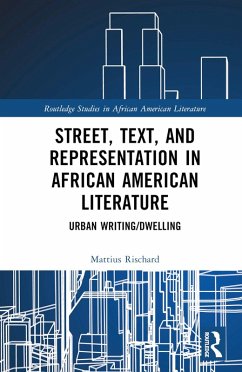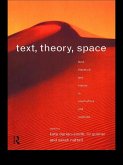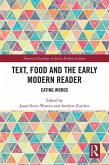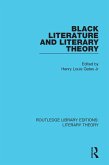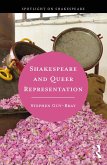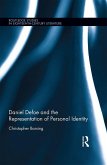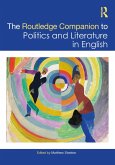Mattius Rischard
Street, Text, and Representation in African American Literature (eBook, PDF)
Urban Writing/Dwelling
43,95 €
43,95 €
inkl. MwSt.
Sofort per Download lieferbar

22 °P sammeln
43,95 €
Als Download kaufen

43,95 €
inkl. MwSt.
Sofort per Download lieferbar

22 °P sammeln
Jetzt verschenken
Alle Infos zum eBook verschenken
43,95 €
inkl. MwSt.
Sofort per Download lieferbar
Alle Infos zum eBook verschenken

22 °P sammeln
Mattius Rischard
Street, Text, and Representation in African American Literature (eBook, PDF)
Urban Writing/Dwelling
- Format: PDF
- Merkliste
- Auf die Merkliste
- Bewerten Bewerten
- Teilen
- Produkt teilen
- Produkterinnerung
- Produkterinnerung

Bitte loggen Sie sich zunächst in Ihr Kundenkonto ein oder registrieren Sie sich bei
bücher.de, um das eBook-Abo tolino select nutzen zu können.
Hier können Sie sich einloggen
Hier können Sie sich einloggen
Sie sind bereits eingeloggt. Klicken Sie auf 2. tolino select Abo, um fortzufahren.

Bitte loggen Sie sich zunächst in Ihr Kundenkonto ein oder registrieren Sie sich bei bücher.de, um das eBook-Abo tolino select nutzen zu können.
Comprehensive and comparative, this volume investigates African American street novelists from the Chicago Black Renaissance and the semiotic strategies they employ in publication, consumption, and depiction of street life.
- Geräte: PC
- mit Kopierschutz
- eBook Hilfe
Andere Kunden interessierten sich auch für
![Text, Theory, Space (eBook, PDF) Text, Theory, Space (eBook, PDF)]() Text, Theory, Space (eBook, PDF)43,95 €
Text, Theory, Space (eBook, PDF)43,95 €![Text, Food and the Early Modern Reader (eBook, PDF) Text, Food and the Early Modern Reader (eBook, PDF)]() Jason Scott-WarrenText, Food and the Early Modern Reader (eBook, PDF)41,95 €
Jason Scott-WarrenText, Food and the Early Modern Reader (eBook, PDF)41,95 €![Black Literature and Literary Theory (eBook, PDF) Black Literature and Literary Theory (eBook, PDF)]() Black Literature and Literary Theory (eBook, PDF)38,95 €
Black Literature and Literary Theory (eBook, PDF)38,95 €![Shakespeare and Queer Representation (eBook, PDF) Shakespeare and Queer Representation (eBook, PDF)]() Stephen Guy-BrayShakespeare and Queer Representation (eBook, PDF)20,95 €
Stephen Guy-BrayShakespeare and Queer Representation (eBook, PDF)20,95 €![Daniel Defoe and the Representation of Personal Identity (eBook, PDF) Daniel Defoe and the Representation of Personal Identity (eBook, PDF)]() Christopher BorsingDaniel Defoe and the Representation of Personal Identity (eBook, PDF)45,95 €
Christopher BorsingDaniel Defoe and the Representation of Personal Identity (eBook, PDF)45,95 €![Cosmopolitan Fictions (eBook, PDF) Cosmopolitan Fictions (eBook, PDF)]() Katherine StantonCosmopolitan Fictions (eBook, PDF)55,95 €
Katherine StantonCosmopolitan Fictions (eBook, PDF)55,95 €![The Routledge Companion to Politics and Literature in English (eBook, PDF) The Routledge Companion to Politics and Literature in English (eBook, PDF)]() The Routledge Companion to Politics and Literature in English (eBook, PDF)45,95 €
The Routledge Companion to Politics and Literature in English (eBook, PDF)45,95 €-
-
-
Comprehensive and comparative, this volume investigates African American street novelists from the Chicago Black Renaissance and the semiotic strategies they employ in publication, consumption, and depiction of street life.
Dieser Download kann aus rechtlichen Gründen nur mit Rechnungsadresse in A, B, BG, CY, CZ, D, DK, EW, E, FIN, F, GR, HR, H, IRL, I, LT, L, LR, M, NL, PL, P, R, S, SLO, SK ausgeliefert werden.
Produktdetails
- Produktdetails
- Verlag: Taylor & Francis eBooks
- Seitenzahl: 238
- Erscheinungstermin: 31. Mai 2024
- Englisch
- ISBN-13: 9781040006184
- Artikelnr.: 70332228
- Verlag: Taylor & Francis eBooks
- Seitenzahl: 238
- Erscheinungstermin: 31. Mai 2024
- Englisch
- ISBN-13: 9781040006184
- Artikelnr.: 70332228
- Herstellerkennzeichnung Die Herstellerinformationen sind derzeit nicht verfügbar.
Mattius Rischard is an Assistant Professor of English at Montana State University-Northern. He received his M.A. and PhD at the University of Arizona from the Department of English and Social, Cultural, and Critical Theory Programs, specializing in African American literature of the 20th century, with focus on the urban novel and digital/visual culture. He has taught writing and literature for the University of Arizona, Pima Community College, and as a Writing Assessment Specialist for the University of Texas system. He publishes and presents on sociohistorical, aesthetic, and phenomenological methods for reading the problematics of modernity across academic, popular, and marginal representations of urban life.
1. Introduction: Writing the Urban Dwelling
a. Black Literary Authenticity: Humanism versus Pessimism
b. Aims, Questions, and Methodologies
c. The Purpose of this Study
d. The Double-Edged Sword of Urban Sociology
e. Street Literature as Responding to the Urban Sociological Mythos
f. A Note on Interpretation and Value
2. Part I: Street
a. Chapter Synopsis
b. Introduction
c. Preparing to Read the Street
d. Street Literature at the Intersection of Blackness and Urbanization
e. The Street Novel: An Urban Differential in Literature
f. A Close Reading of Two Gen(d)erations in Street Novels: Iceberg Slim
g. A Close Reading of Two Gen(d)erations in Street Novels: Sister Souljah
h. Conclusion
3. Part II: Text
a. Chapter Synopsis
b. Introduction: Four Tropes of the Street-as-Text
c. Temporal Factors Affecting Tropological Semantics
d. Passing: A Comparative Reading of Himes, Beck, and Tyree
e. Peddling: A Comparative Reading of Autobiographical Street Fiction
f. Pandering: A Comparative Reading of Sexual Exchange and Economy
g. Preaching: A Comparative Reading of Demagogues and Messiahs
h. Rinehart's Face(lessness): (De)constructing the Four Tropes
i. Rinehartism and the Author-Function Problem in Street Literature
j. Defining Rinehartism with Strong Semantics
k. Table 1: The Ontology of Rinehartism
l. Conclusion
4. Part III: Representation
a. Chapter Synopsis
b. Introduction
c. Language Structures the Expression of (Black) Being
d. Implications of Language that Frames Being-in-the-Street
e. The Ethical Work of Street Novels
f. Satirizing Street Publishing: Tyree and Everett
g. Satirizing Street Movements: The Fanonian Ontology of Wideman
h. Satirizing Street Culture: Beatty and Mansbach
i. The Postmodernism of Street Satire
j. Conclusion
5. Conclusion; or, Redefining Street Cultural Production
a. Introduction
b. Music
c. Image
d. Text
e. Praxis
f. Conclusion
a. Black Literary Authenticity: Humanism versus Pessimism
b. Aims, Questions, and Methodologies
c. The Purpose of this Study
d. The Double-Edged Sword of Urban Sociology
e. Street Literature as Responding to the Urban Sociological Mythos
f. A Note on Interpretation and Value
2. Part I: Street
a. Chapter Synopsis
b. Introduction
c. Preparing to Read the Street
d. Street Literature at the Intersection of Blackness and Urbanization
e. The Street Novel: An Urban Differential in Literature
f. A Close Reading of Two Gen(d)erations in Street Novels: Iceberg Slim
g. A Close Reading of Two Gen(d)erations in Street Novels: Sister Souljah
h. Conclusion
3. Part II: Text
a. Chapter Synopsis
b. Introduction: Four Tropes of the Street-as-Text
c. Temporal Factors Affecting Tropological Semantics
d. Passing: A Comparative Reading of Himes, Beck, and Tyree
e. Peddling: A Comparative Reading of Autobiographical Street Fiction
f. Pandering: A Comparative Reading of Sexual Exchange and Economy
g. Preaching: A Comparative Reading of Demagogues and Messiahs
h. Rinehart's Face(lessness): (De)constructing the Four Tropes
i. Rinehartism and the Author-Function Problem in Street Literature
j. Defining Rinehartism with Strong Semantics
k. Table 1: The Ontology of Rinehartism
l. Conclusion
4. Part III: Representation
a. Chapter Synopsis
b. Introduction
c. Language Structures the Expression of (Black) Being
d. Implications of Language that Frames Being-in-the-Street
e. The Ethical Work of Street Novels
f. Satirizing Street Publishing: Tyree and Everett
g. Satirizing Street Movements: The Fanonian Ontology of Wideman
h. Satirizing Street Culture: Beatty and Mansbach
i. The Postmodernism of Street Satire
j. Conclusion
5. Conclusion; or, Redefining Street Cultural Production
a. Introduction
b. Music
c. Image
d. Text
e. Praxis
f. Conclusion
1. Introduction: Writing the Urban Dwelling
a. Black Literary Authenticity: Humanism versus Pessimism
b. Aims, Questions, and Methodologies
c. The Purpose of this Study
d. The Double-Edged Sword of Urban Sociology
e. Street Literature as Responding to the Urban Sociological Mythos
f. A Note on Interpretation and Value
2. Part I: Street
a. Chapter Synopsis
b. Introduction
c. Preparing to Read the Street
d. Street Literature at the Intersection of Blackness and Urbanization
e. The Street Novel: An Urban Differential in Literature
f. A Close Reading of Two Gen(d)erations in Street Novels: Iceberg Slim
g. A Close Reading of Two Gen(d)erations in Street Novels: Sister Souljah
h. Conclusion
3. Part II: Text
a. Chapter Synopsis
b. Introduction: Four Tropes of the Street-as-Text
c. Temporal Factors Affecting Tropological Semantics
d. Passing: A Comparative Reading of Himes, Beck, and Tyree
e. Peddling: A Comparative Reading of Autobiographical Street Fiction
f. Pandering: A Comparative Reading of Sexual Exchange and Economy
g. Preaching: A Comparative Reading of Demagogues and Messiahs
h. Rinehart's Face(lessness): (De)constructing the Four Tropes
i. Rinehartism and the Author-Function Problem in Street Literature
j. Defining Rinehartism with Strong Semantics
k. Table 1: The Ontology of Rinehartism
l. Conclusion
4. Part III: Representation
a. Chapter Synopsis
b. Introduction
c. Language Structures the Expression of (Black) Being
d. Implications of Language that Frames Being-in-the-Street
e. The Ethical Work of Street Novels
f. Satirizing Street Publishing: Tyree and Everett
g. Satirizing Street Movements: The Fanonian Ontology of Wideman
h. Satirizing Street Culture: Beatty and Mansbach
i. The Postmodernism of Street Satire
j. Conclusion
5. Conclusion; or, Redefining Street Cultural Production
a. Introduction
b. Music
c. Image
d. Text
e. Praxis
f. Conclusion
a. Black Literary Authenticity: Humanism versus Pessimism
b. Aims, Questions, and Methodologies
c. The Purpose of this Study
d. The Double-Edged Sword of Urban Sociology
e. Street Literature as Responding to the Urban Sociological Mythos
f. A Note on Interpretation and Value
2. Part I: Street
a. Chapter Synopsis
b. Introduction
c. Preparing to Read the Street
d. Street Literature at the Intersection of Blackness and Urbanization
e. The Street Novel: An Urban Differential in Literature
f. A Close Reading of Two Gen(d)erations in Street Novels: Iceberg Slim
g. A Close Reading of Two Gen(d)erations in Street Novels: Sister Souljah
h. Conclusion
3. Part II: Text
a. Chapter Synopsis
b. Introduction: Four Tropes of the Street-as-Text
c. Temporal Factors Affecting Tropological Semantics
d. Passing: A Comparative Reading of Himes, Beck, and Tyree
e. Peddling: A Comparative Reading of Autobiographical Street Fiction
f. Pandering: A Comparative Reading of Sexual Exchange and Economy
g. Preaching: A Comparative Reading of Demagogues and Messiahs
h. Rinehart's Face(lessness): (De)constructing the Four Tropes
i. Rinehartism and the Author-Function Problem in Street Literature
j. Defining Rinehartism with Strong Semantics
k. Table 1: The Ontology of Rinehartism
l. Conclusion
4. Part III: Representation
a. Chapter Synopsis
b. Introduction
c. Language Structures the Expression of (Black) Being
d. Implications of Language that Frames Being-in-the-Street
e. The Ethical Work of Street Novels
f. Satirizing Street Publishing: Tyree and Everett
g. Satirizing Street Movements: The Fanonian Ontology of Wideman
h. Satirizing Street Culture: Beatty and Mansbach
i. The Postmodernism of Street Satire
j. Conclusion
5. Conclusion; or, Redefining Street Cultural Production
a. Introduction
b. Music
c. Image
d. Text
e. Praxis
f. Conclusion
